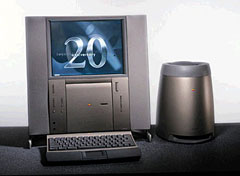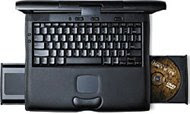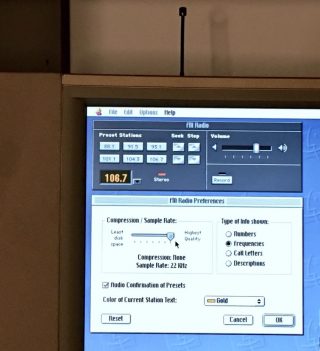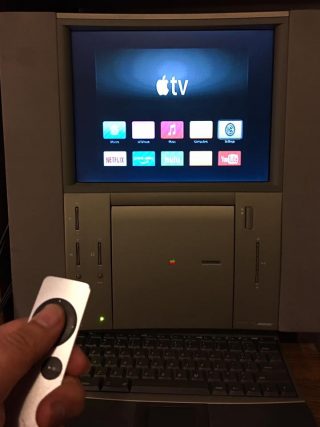The eve of the Ides of March this year marks 2 decades since the inglorious end of a year-long failed experiment by Apple Computer (among many at the time). Nevertheless, the 20th Anniversary Mac would become a bellwether of the groundbreaking products to come under the guidance of newly-returned “interim CEO” Steve Jobs.

The 20th Anniversary Mac is now old enough to order itself a drink.
Flashback
The mid-90s were not a good time to be a Mac fan, with Apple on the brink of falling apart. At the time, I was working on The Journeyman Project, a game series that reached a larger audience on PCs but owed its existence to the Mac.
Part of the development team at Presto Studios almost mutinied when it was floated (albeit briefly) that The Journeyman Project 3 would be Windows-only. Fortunately, the Mac fanatics prevailed, and by the time the game shipped in early 1998, things were already turning around at Apple.
Steve Jobs was about to announce a new PowerBook that would support brand new technologies. This was top secret. We didn’t even know what this product would look like, but we had to deliver our game in a new format that had not yet been widely used for games — DVD-ROM. Imagine our surprise when we saw it unveiled during the next “Stevenote”. This all happened on short notice. Apple was back on the move.

Apple announced the PowerBook G3 Series with DVD-ROM in March 1998, as the TAM was being discontinued.
However, before launching the new PowerBook G3 Series, Steve Jobs also had to get rid of one last project that was green-lit by his predecessor — the Twentieth Anniversary Macintosh (a.k.a. “TAM”). It was overpriced at $7,499 (over $11K today), but it stood out among the Mac lineup through the clever packaging of technologies into an extraordinarily sleek design.
Jobs had the price cut to $3,499 and then $1,999 in a final blowout. Within weeks the entire inventory was completely gone. I managed to pick up one of the very last units available.

The analog TV tuner is now useless, but the radio still works.
Jobs stated that he hated the TAM, but thankfully he kept the wunderkind designer behind this system — Jonathan Ive. Anyone who complained about the price cuts was placated with a complimentary new PowerBook G3, also designed by Ive.
Perhaps what Jobs hated about the TAM was less about the design and was more accurately represented by the ill-conceived “concierge service” for elite owners. Jobs wanted these features to be available to everyone, and the experience of seeing the TAMs moving briskly at the right price may have played a part in the aggressive $1,299 price of the iMac later that year.
Back to the Future
20 years have passed, and there’s an interesting phenomenon on eBay. Vintage Macintosh Portables and Pluses regularly pop up, but they’re often listed “as is”, “for parts”, or “not working”. The ones that do work profess that their faulty capacitors have been replaced.

Bruce Wayne obviously liked the TAM so much that he got the prototype for Alfred in Batman & Robin.
A small but steady stream of TAMs also remains available. However, despite their age, most appear to be in good working order and retain substantial market value — much more if the original accessories, such as the leather-bound CD case, are included. In hindsight, it’s nice that Apple didn’t skimp on components in this model. Though having become more brittle with age, the bronzed plastics mask any sign of yellowing that typically plagues old electronics. The main logic board sports higher-quality solid capacitors that have long outlived cheaper counterparts. The Bose Acoustimass speaker system sounds as wonderful as ever (as long as there’s no buzz from oxidation in the electrical contacts).

AppleTV can only be hooked up to a TAM in standard-definition, but it sounds great through the Bose speakers.
Though still perfectly functional, these working units are a snapshot of computer performance in the late 1990s. The 250 MHz 603ev is borderline unusable to surf today’s internet. The included GeoPort Telecom Adapter modem is quaint as one wonders if any dial-up numbers are still left in service.
The Classic Enthusiasts
The folks on Low End Mac’s Facebook group remind me of a colleague from the game industry who likes to restore and customize exotic cars in his spare time. It’s not so much about tech support — some of these power users are more like the VW owners who will drop in a V8 to see if it’ll work. They like to push the limits of Macs way beyond their original specifications.
From G3 processor upgrades to adding faster network connectivity, many of the discussions focus on maintaining these unique Apple specimens so that they’ll still be running 20 years from now. There’s even a Facebook group just for the 20th Anniversary Mac.
keywords: #tam #20thanniversarymac
short link: https://goo.gl/hL5c37

